There’s something exciting about shopping for a new instrument. It may be the guilty pleasure of adding to a pre-existing collection, or the riveting feeling of embarking on a new facet of your life.
Wherever that excitement comes from, it is quickly accompanied by a desire to learn more about the instrument you’re aching to buy and what options are available. So long as that instrument is a bass guitar, you can trust that we’ve got what you’re looking for. Below, we’ll be discussing the best bass guitars at different price points.
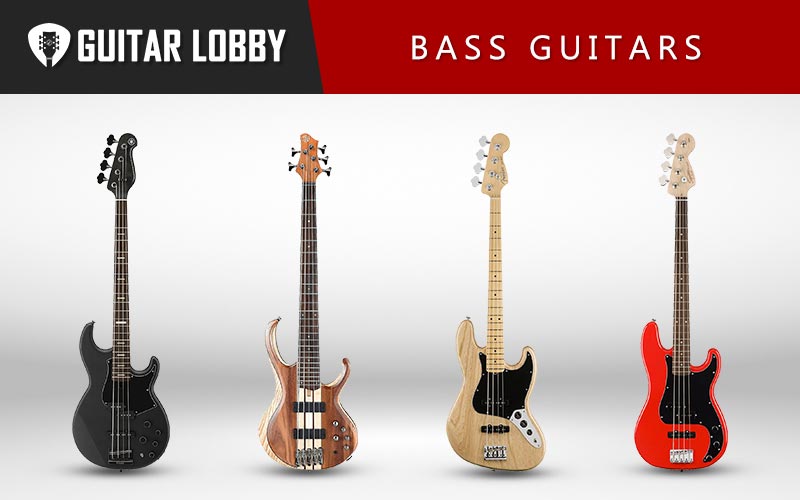
If you’re a seasoned bassist or you’ve already conducted your research, then you are all set to do your shopping. However, if you’re new to the bass and you need some guidance, we have a buying guide at the bottom of the page that will get you up to snuff on what you should be looking for in a bass guitar as well as the lingo that I’ll be using in the reviews. This will make it easy to find the instrument best suited for you.
| Name of Product | Image of Product | Description | Price Range | Full Review |
|---|---|---|---|---|
| 1. Fender American Professional Jazz Bass (Best Four-string) | 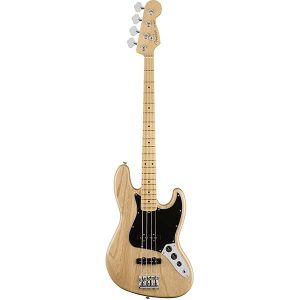 | Strings: 4 Fret Count: 20 | $1550 | Read Full Review Below |
| 2. Ernie Ball Music Man StingRay 4 Special HH (Best Active Four-string) | 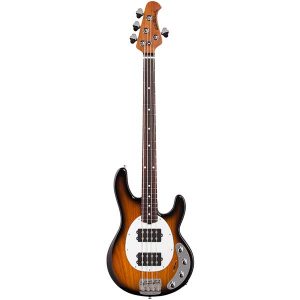 | Strings: 4 Fret Count: 22 | $2300 | Read Full Review Below |
| 3. Schecter Stiletto Studio-5 (Best Five-string) | 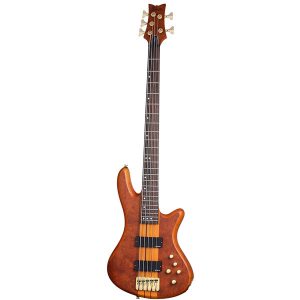 | Strings: 5 Fret Count: 24 | $900 | Read Full Review Below |
| 4. Fender Player Precision Bass (Best Under $700) | 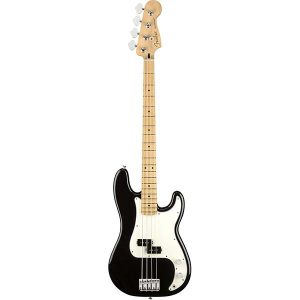 | Strings: 4 Fret Count: 20 | $700 | Read Full Review Below |
| 5. Yamaha BB434 (Best Under $500) | 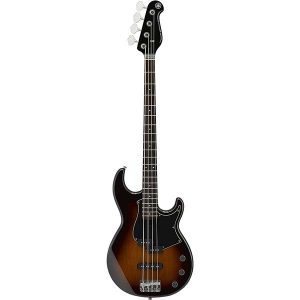 | Strings: 4 Fret Count: 21 | $500 | Read Full Review Below |
| 6. Squier by Fender Affinity Series Precision Beginner Electric Bass | 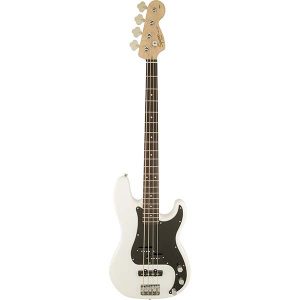 | Strings: 4 Fret Count: 20 | $230 | Read Full Review Below |
| 7. Gretsch 5440LS Electromatic | 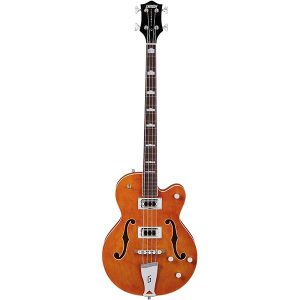 | Strings: 4 Fret Count: 22 | $1000 | Read Full Review Below |
| 8. Fender Deluxe Active Precision Bass Special | 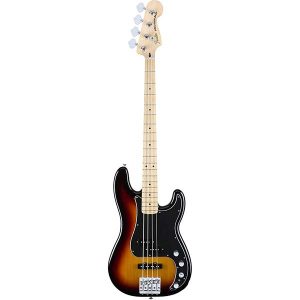 | Strings: 4 Fret Count: 20 | $830 | Read Full Review Below |
| 9. Ibanez BTB745 | 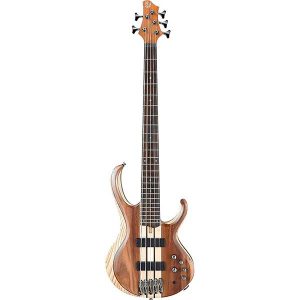 | Strings: 5 Fret Count: 24 | $900 | Read Full Review Below |
| 10. Fender Player Jazz Bass V | 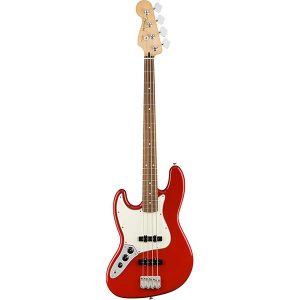 | Strings: 5 Fret Count: 20 | $800 | Read Full Review Below |
| 11. Ibanez SR506E | 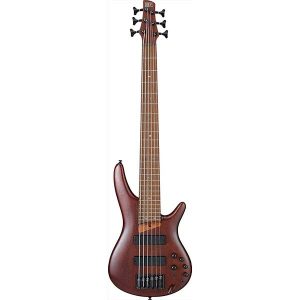 | Strings: 6 Fret Count: 24 | $750 | Read Full Review Below |
| 12. Fender Mustang PJ Bass | 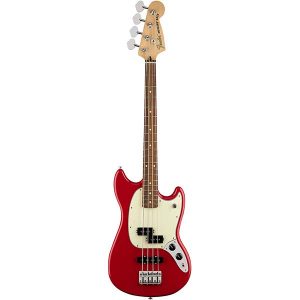 | Strings: 4 Fret Count: 19 | $550 | Read Full Review Below |
| 13. Guild Jumbo Junior Acoustic-Electric Bass | 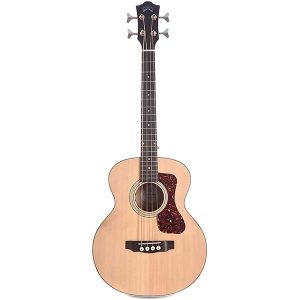 | Strings: 4 Fret Count: 19 | $500 | Read Full Review Below |
| 14. Fender Player Fretless Jazz Bass | 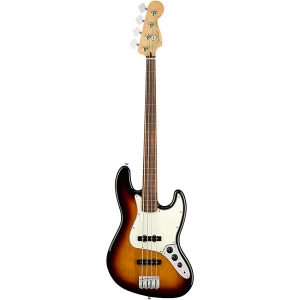 | Strings: 4 Fret Count: Fretless | $700 | Read Full Review Below |
| 15. Yamaha TRBX605FM | 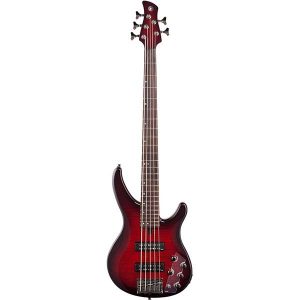 | Strings: 5 Fret Count: 24 | $650 | Read Full Review Below |
| 16. Epiphone EB-3 | 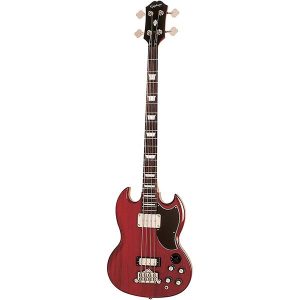 | Strings: 4 Fret Count: 22 | $650 | Read Full Review Below |
| 17. Squier Classic Vibe Bass VI | 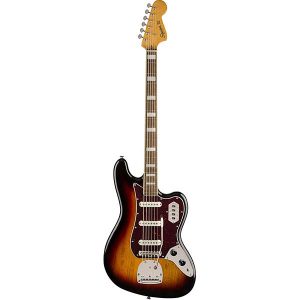 | Strings: 6 Fret Count: 21 | $500 | Read Full Review Below |
| 18. Ibanez AGB200 | 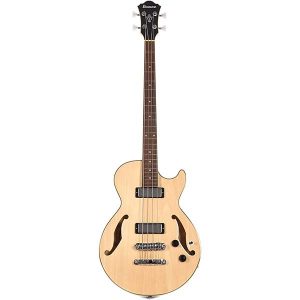 | Strings: 4 Fret Count: 22 | $550 | Read Full Review Below |
| 19. Squire Classic Vibe 70s Jazz Bass V | 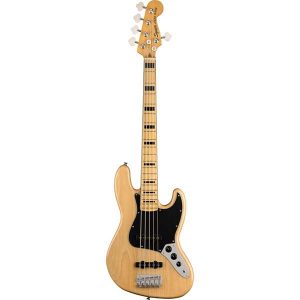 | Strings: 5 Fret Count: 20 | $450 | Read Full Review Below |
| 20. Gretsch G2220 Junior Jet Bass | 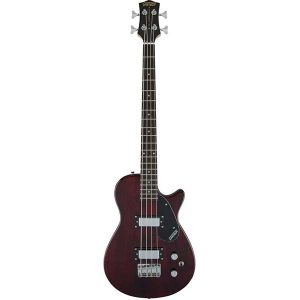 | Strings: 4 Fret Count: 20 | $300 | Read Full Review Below |
| 21. Ibanez Talman TMB-100 | 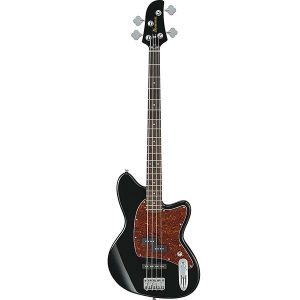 | Strings: 4 Fret Count: 20 | $200 | Read Full Review Below |
Here Are the Best Bass Guitars
1. Fender American Professional Jazz Bass (Best Four-string)
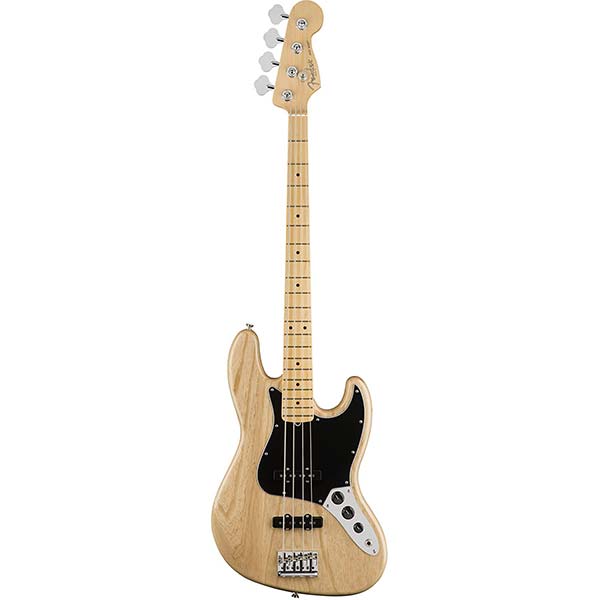
| Estimated Price | $1550 |
| Strings | 4 |
| Body Wood | Alder |
| Finish | Gloss, polyurethane |
| Neck | Maple, Modern C profile, satin finish |
| Neck Joint | Bolt-on |
| Fingerboard | Rosewood |
| Fret Count | 20 |
My Review: The Fender Jazz Bass is one of the most iconic electric basses of all time. While it’s predecessor, the Precision Bass, rivals it’s popularity as the first mass-produced bass guitar, the extra tonal options available on the Jazz Bass cemented it as a classic and allowed it to surpass the P-Bass. Fender’s American Professional line has its most expensive, but also its highest quality instruments available on the market. While Fender is known for producing excellent instruments at every price point, when you play an American Jazz Bass it’s easy to tell that no corners were cut. Though the Jazz Bass is a relatively simple design, it is the chosen instrument of bass virtuosos such as Jaco Pastorius and Marcus Miller.
Build Materials: A solid alder body allows the bass to remain fairly lightweight, while also providing excellent sustain and enhancing low-end. Like most Fenders, the neck is maple with a walnut skunk stripe down the back giving it a traditional look. Though rosewood fingerboards are more popular and common, maple fingerboards are also available.
Hardware, Electronics, and Controls: The HiMass bridge allows better transfer of vibration from the string to the body which adds sustain and brings out the tonewood characteristics of the alder wood body. It also allows for thru-body or top-loaded stringing. The tuning machines have high-ratio gears which aid in tuning stability and more precise adjustments. The keys are vintage clover shapes that compliment the classic headstock shape and add to the classic vibe. The two V-Mod single-coils each have their own volume so you can blend them to your taste, and they are both linked to a master tone control.
Finish: The body has a durable polyurethane gloss finish. It’s available in a large variety of colors such as classic Candy Apple Red and Sunburst, or more modern finishes like Sonic Gray and Olympic White. The neck has a satin finish which has a natural feel when opposed to gloss necks (it’s also great for players with sweaty hands).
Bottom Line: The Jazz Bass takes the top of the list and the best four-string because it is suitable for pretty much any player in any genre. Its versatility largely outways its popularity and is the main reason that it is one of the most popular basses on the market. While I thought it was fitting to place the Jazz Bass from Fender’s American Professional line in the top place, Fender also has excellent affordable options from their Mexican and East-Asian factories if you are looking for a Jazz Bass on a tighter budget. We will be looking at some of these later on in the list, so stay tuned. Overall, this is easily one of the best bass guitars for the money.
2. Ernie Ball Music Man StingRay 4 Special HH (Best Active Four-string)
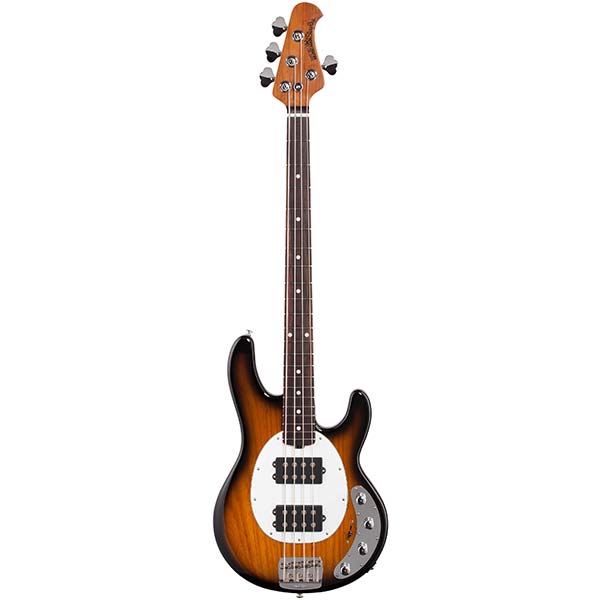
| Estimated Price | $2300 |
| Strings | 4 |
| Body Wood | Ash |
| Finish | Gloss |
| Neck | Roasted maple, satin finish |
| Neck Joint | Bolt-on |
| Fingerboard | Ebony, roasted maple, or rosewood |
| Fret Count | 22 |
My Review: While the Jazz bass isn’t very disputed as the best passive four-string on the market, this one is probably up for some hefty debate. Nevertheless, it’s my list and I’ve decided to give this top spot to a classic… or the redesign of a classic. While Fender may be the place to go for a traditional and versatile passive bass, where do you go if you want a little extra gain? Ernie Ball Music Man is where you go. The Music Man StingRay Special is one of the most popular active basses on the market, and for good reason. The tone that comes out of this instrument before it even goes through any effects sounds like a bassist’s dream. It’s high-gain growl and three-band EQ makes it perfect for audiophiles of any genre. Though there is a single pickup model available (at a low price) I placed the newer double humbucker model here because of the extra options it provides in tone shaping.
Build Materials: An ash body gives this bass a brighter and harsher sound when compared to the alder that Fender typically uses. This, when paired with the active preamp, gives the StingRay tons of presence which makes it stand out in any mix. The neck is roasted maple which gives it a beautifully unique look. The StingRay Special is made with rosewood, ebony, and roasted maple fingerboards, so the voice is up to you!
Hardware, Electronics, and Controls: Lightweight tuning machines and a top-loaded bridge plate help to keep the weight down (and your back in good shape). While most active basses have a 9v preamp (older StingRay models included), the StingRay Special boasts an 18v preamp. It also has a three-band EQ and two neodymium humbuckers with a 5-way selector switch for endless tone-shaping options.
Finish: The StingRay Special has a gloss body finish and a satin neck finish. It’s available in a huge variety of colors from Cruz Teal to Burnt Apple, with just about every color in between!
Bottom Line: If you want a classic bass that can fit into any genre, but you’re itching for an active preamp and EQ, the StingRay Special is perfect for you. However, I haven’t forgotten about the price tag. $2,300 is steep for even the most serious musicians (especially if that’s how you make your living). Luckily, Music Man also has a company that produces cheaper, more affordable basses called Sterling (similar to Fender’s Squire). We’ll dig into that later on in the list.
3. Schecter Stiletto Studio-5 (Best Five-string)
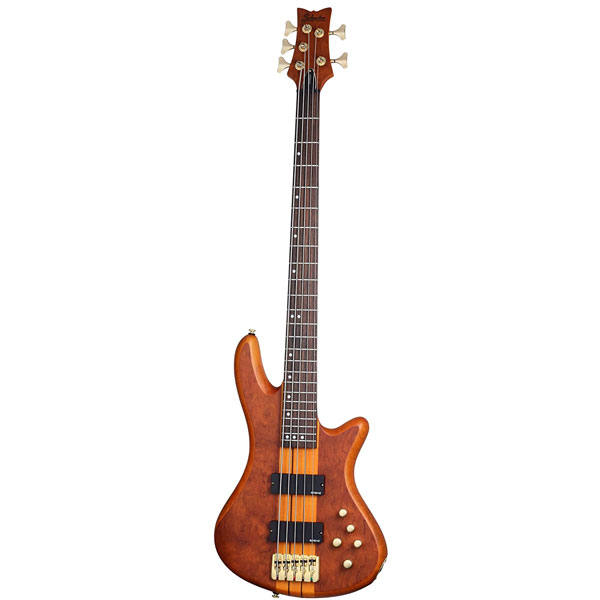
| Estimated Price | $900 |
| Strings | 5 |
| Body Wood | Mahogany wings, Bubinga top |
| Finish | Satin |
| Neck | Multi-laminate maple and walnut, satin finish |
| Neck Joint | Set, neck-thru, Thin C profile |
| Fingerboard | Rosewood |
| Fret Count | 24 |
My Review: Though the first two basses on the list won their places partially due to classic designs and popular manufacturers, this next bass steals the place for best five-string through sheer quality (and looks, maybe) alone. The Schecter Studio-5 is a gorgeous bass that is anything but traditional. It sports a set maple and walnut neck that runs the entire length of the body, mahogany wings topped with a beautiful Bubinga, and a Honey Satin finish. It’s all topped off with satin golden hardware to complete the look. Of course, it wouldn’t be on this list if it didn’t sound the part as well. It naturally has a beautifully warm tone with a strong low mids presence. With a little extra bite from the 18v preamp and tons of tone-shaping options from the EQ, this bass is golden (no pun intended).
Build Materials: As I mentioned before, this bass naturally has a strong low mids presence. This is due to the mahogany wings. Along with the Bubinga top, the body doesn’t only look beautiful, but it sounds beautiful as well. It has great sustain, a warm overall tone, strong bass and low mids, and a less pronounced, but soft and pleasant high end. The maple neck is broken up by two strips of walnut, giving it a gorgeous double skunk-stripe along the entire length of the bass.
Hardware, Electronics, and Controls: The two EMG-40hz pickups and 3-band active EQ provide a lot of tone control. Though I’m not personally a fan of gold hardware, it is very much warranted in this case, and it suits the look splendidly. It has Grover triangle key tuning machines and a Diamond Custom five-saddle top-loaded bridge.
Finish: Though a See-Thru Black Satin finish with Black Chrome hardware is available, the Honey Satin finish is much more popular. In my opinion, it’s easy to see why. The natural tints of the wood shine through the Honey Satin finish beautifully and give it a unique look. While you can technically see the wood grain through the Black Satin finish, it all just appears kind of… well, black. To each his own, though!
Bottom Line: If you want a traditional-looking five-string bass, then you’d do best to carry on through the list. However, if you’re willing to try something a bit more modern, you will not be disappointed by the Schecter Stiletto Studio 5. It has a wonderfully warm tone, and it is stunning to look at. Also, those classic vibes come with a price. The Stiletto can go head-to-head with the American Jazz Bass and the StingRay Special, but it’s almost half the price.
Popular Related Article: The Best Bass Guitars for Beginners (All Price Ranges)
4. Fender Player Precision Bass (Best Under $700)
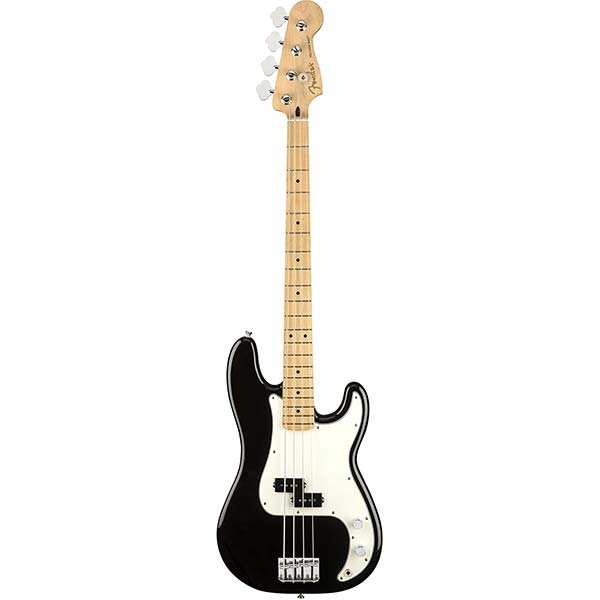
| Estimated Price | $700 |
| Strings | 4 |
| Body Wood | Alder |
| Finish | Gloss |
| Neck | Maple, satin finish, Modern C profile |
| Neck Joint | Bolt-on |
| Fingerboard | Maple or Pau Ferro |
| Fret Count | 20 |
My Review: We’re going back to basics with this one. While the Jazz Bass may be top of the list in popularity, the P-bass follows closely behind. Popular for its elegant and simple setup, the P-bass was the first commercially successful bass guitar on the market, so it isn’t going anywhere. Though there is also an American Professional P-bass, I figured I’d introduce Fender’s Player Series with this model. The Player Series is Fender’s mid-range line from their Mexican factory, and it is honestly the best bang for your buck on the market if you are set on a classic Fender Bass. Though the hardware and electronics are a step down from the American Professional line, the Player Series still makes incredibly high-quality instruments that many professional bassists rely on. Also, the price is much more realistic for the working musician!
Build Materials: The woods here are almost identical to the American Jazz Bass. It has an alder body, maple neck with a walnut skunk stripe, and a maple or Pau Ferro fingerboard.
Hardware, Electronics, and Controls: Unlike the American models, the Player P-bass has a standard top-loaded bridge plate with no thru-body option. The tuning machines are also standard, but they still have the traditional clover keys. A single Alnico V Split Coil pickup with a volume and tone knob provides an excellent classic tone in the simplest setup.
Finish: This P-bass has a satin neck finish to allow for comfortable playing. The body finish is gloss and available in a large variety of colors including a 3-tone Sunburst, Buttercream, Tidepool, and Capri Orange.
Bottom Line: If a more traditional tone and feel is your thing and you need a high-quality instrument that won’t break the bank, the Player Series Precision Bass is a no-brainer. If the P-bass isn’t quite your style, but the price is right, be sure to check out the other Mexican models available. The Player Series has some of the best values on the market for authentic Fender basses, and with a ton of options available (some of which might even pop up later on in the list), you are bound to find something that suits your taste. This is easily one of the best bass guitars out there and I would highly recommend it to anyone looking for a solid bass guitar under $1000.
5. Yamaha BB434 (Best Under $500)

| Estimated Price | $500 |
| Strings | 4 |
| Body Wood | Alder |
| Finish | Gloss |
| Neck | 5-piece maple/mahogany |
| Neck Joint | 6-bolt Miter joint |
| Fingerboard | Rosewood |
| Fret Count | 21 |
My Review: Some people need a Fender and anything that’s not on brand is a deal-breaker. I can understand that. Fender’s quality control is excellent, and I’m hesitant to go to another brand for a clone of a Jazz or P-bass. However, there are some basses out there that emulate the classic tones of those basses but put them in a unique package that looks and feels much more authentic than copying Fender note for note. A prime example of a bass that does this is the Yamaha BB434.
Build Materials: While the style of this bass is unique and it has some different features, the basics imitate Fender basses. It has a contoured alder body with a double-cutaway. The body is a bit wider than a Jazz or P-bass, though. The neck is a 5-piece laminate of maple and mahogany, giving it two dark skunk stripes that carry into the headstock.
Hardware, Electronics, and Controls: The BB434 has a standard 4-saddle bridge plate that can be top-loaded or thru-body. The thru-body anchors are at an angle to the bridge which provides more flexibility in the strings. The tuning machines have open gears and clover tuning keys. It has both precision and jazz style Alnico V pickups. Like a PJ or Jazz bass, the BB434 has a volume for each pickup and a master tone.
Finish: The neck finish is satin and the headstock is finished in black gloss, which helps to distinguish it from similar Fender basses. The body finish is also gloss and it comes Black, Teal Blue, or Tobacco Brown Sunburst.
Bottom Line: Though the Broad Bass line spans a large price range, the BB434 takes the Best Under $500 spot. It has just enough unique features without pushing the price out of a moderate budget. Its wider body and glossed headstock help it to stand out from the crowd of Fender imitations, and the sound quality and classic tones that it produces gives you some serious bang for your buck. It’s one of the best values on this list, and probably my personal favorite if that counts for anything!
Popular Related Article: Our Favorite Bass Guitars for Metal Music
6. Squier by Fender Affinity Series Precision Beginner Electric Bass
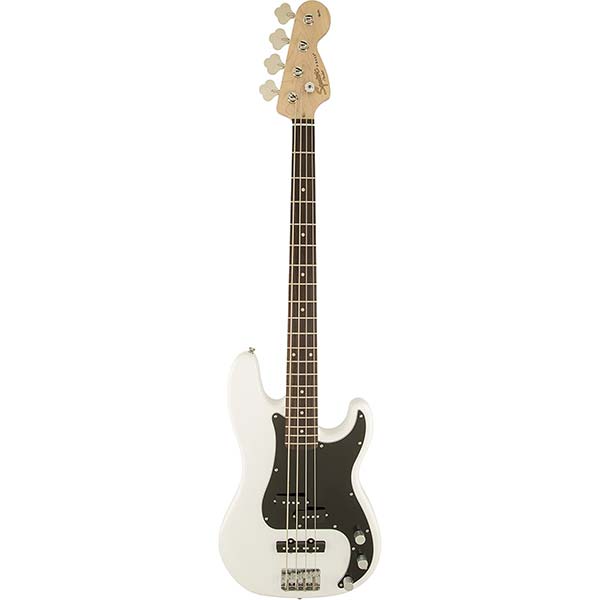
| Estimated Price | $230 |
| Strings | 4 |
| Body Wood | Poplar |
| Finish | Gloss |
| Neck | Maple, satin finish, Modern C profile |
| Neck Joint | Bolt-on |
| Fingerboard | Indian laurel |
| Fret Count | 20 |
My Review: For those who are unfamiliar, Squire is a company by Fender that produces their lower-end instruments overseas. While some may turn their nose up at Squire, the quality of the instruments they produce is still up to Fender’s manufacturing standards. If you’re on a tight budget but you still want the classic look of a Fender, Squire is the way to go. Though you will sacrifice the quality of the wood and pickups for such a low price, the construction quality, look, and tone will all feel like a true Fender. Unlike a standard P-bass, the Affinity Precision Bass also includes a Jazz Bass pickup by the bridge. This provides a fair amount of tonal options and combines the simplicity of the P-bass with the versatility of a Jazz Bass.
Build Materials: Though poplar is closest to alder (which is used for Fender products) since it sustains low-end frequencies well, it is a lot less effective and doesn’t stand out as a particularly characteristic tonewood. The neck is maple to match higher-end Fenders, though it lacks a skunk stripe on the back. The fingerboard is made of Indian laurel, which imitates rosewood quite well. Overall the wood quality is less than Fender instruments, but with Fender’s quality control and manufacturing standards, you can be sure that this instrument will still be well constructed and trustworthy.
Hardware, Electronics, and Controls:The bridge is a standard four-saddle top-loaded bridge plate, and the tuners are standard, open geared machines with clover keys. There are separate volume controls for the standard split single-coil P-bass pickup and the standard single-coil Jazz Bass pickup, and a master tone knob.
Finish: The neck finish is satin to provide a smooth feel. The body finish is gloss and it comes in Black, Olympic White, and Race Red
Bottom Line: Though it’s constructed with materials and electronics of significantly lower quality the Fender instruments, the overall quality of the construction and the tone it produces is phenomenal for the price. If you’re on a tight budget, but the classic Fender look is a must for you, the Affinity Precision Bass might just be the way to go.
7. Gretsch 5440LS Electromatic
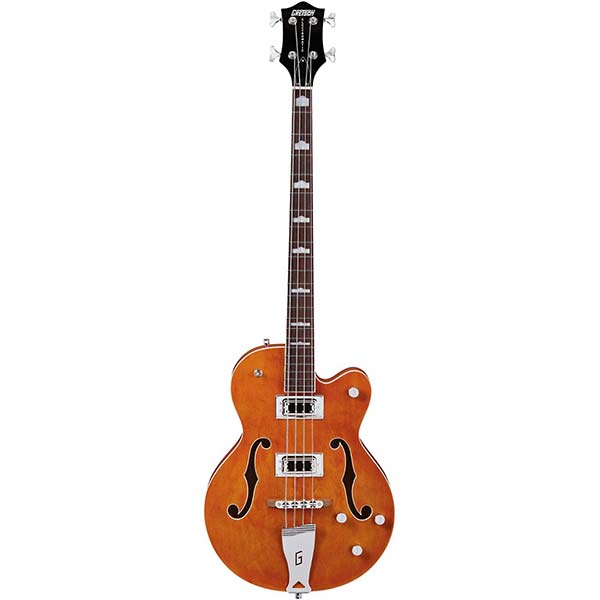
| Estimated Price | $1000 |
| Strings | 4 |
| Body Wood | Laminate maple |
| Finish | Gloss |
| Neck | Maple, gloss finish |
| Neck Joint | Set |
| Fingerboard | Rosewood |
| Fret Count | 22 |
My Review: Gretsch is one of the most popular hollow-body guitar manufacturers on the market, so it would be crazy not to pick one of their instruments for our first hollow-body bass. While most Gretsch instruments are made overseas, the quality of these instruments is more akin to mid-range and high-end Fenders than the lower end Squires that are also produced in south-east Asian countries. So don’t be dismayed by the “Made in Korea” stamp; Gretsch’s Asain factories are top-notch, and their instruments are well worth the price tag if you’re willing to make the investment. Given Gretsch’s legacy in hollow-body guitars, the 5440LS Electromatic is one of the best options on the market if you’re looking for a hollow-body bass. It has that lively wooden tone that stands out beautifully from solid body basses.
Build Materials: The entire body is constructed from laminated maple. Though it is stiffer and less resonant than solid carved wood that is typical in high-end acoustic instruments, it’s a compromise that makes this bass incredibly sturdy and prevents it from cracking or splitting due to humidity or temperature changes. The set neck follows the maple trend, and the fretboard deviates to rosewood. The 5440LS Electromatic is also a full 34” scale, which is rather difficult to find among hollow and semi-hollow basses. The body, neck, and soundholes are all wrapped in a cream binding to give it a beautiful vintage look.
Hardware, Electronics, and Controls: The bridge is an Adjusto-Matic with a rosewood bass. The two Filter’Tron Humbucker pickups can be selected with a 3-way switch. There are a master volume and a master tone knob, and each pickup has its own volume. The tuners are standard die-cast machines with triangle keys.
Finish: Both the body and neck finishes are gloss and though it only comes in orange, it suits the look so well that I’d be surprised if anyone would complain. The headstock is finished in black with a classic white “Gretsch Electromatic” badge.
Bottom Line: If you want the warm woody tone of a hollow-body, and you don’t mind investing some money into it, the Gretsch 5440LS Electromatic is the perfect way to go. Besides looking gorgeous, this bass is a true workhorse. Very few hollow-bodies can boast a full 34” scale and such a wide variety of tonal options. As far as hollow basses go, this is the cream of the crop.
Popular Related Article: The Bass Pickups Currently on the Market
8. Fender Deluxe Active Precision Bass Special
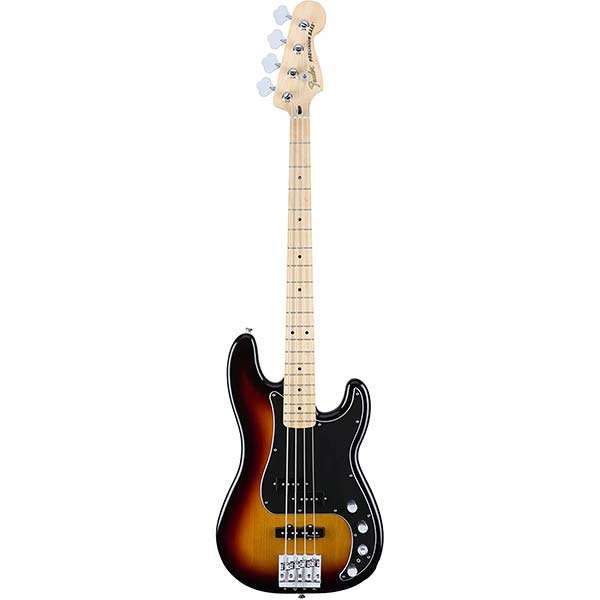
| Estimated Price | $830 |
| Strings | 4 |
| Body Wood | Alder |
| Finish | Gloss |
| Neck | Maple, satin finish, C profile |
| Neck Joint | Bolt-on |
| Fingerboard | Maple or Pau Ferro |
| Fret Count | 20 |
My Review: Do the classic vibes of a Fender Jazz or Precision Bass catch your interest, but you’re worried that they just won’t quite have that bite or power that you’re looking for? Well, Fender’s got you covered, because their Deluxe line might have just what you’re looking for. The Deluxe Active Precision Bass Special is a traditional P-bass body with a PJ pickup configuration and an 18v active preamp driving a 3-band EQ. Like the Player series, it’s a product of Fender’s Mexican factories and it’s the perfect solution for anyone who wants a classic Fender with a little boost and an extensive EQ.
Build Materials: Like all of the other Fenders on this list, the Deluxe Active P-bass has an alder body and a maple neck with a walnut skunk stripe. You can choose between a maple or Pau Ferro fingerboard.
Hardware, Electronics, and Controls: The bridge is a high-mass top-loaded bridge plate, and the tuners are standard open-geared machines with clover keys. The split-coil pickup is a Vintage Precision Bass pickup, and the bridge is a Dual-coil ceramic Noiseless Jazz Bass pickup. A master volume and pan knob allow you to adjust the volume and blend of the two pickups, and the remaining controls make up a 3-band active EQ.
Finish:The neck finish is satin and the body is gloss. It’s available in 3-color Sunburst, Surf Pearl, or Olympic White.
Bottom Line: By the looks of it, this may seem like just another Precision Bass with a Jazz pickup added on. However, the addition of an 18v preamp and an active EQ make this bass the perfect option for audiophile Fender freaks.
9. Ibanez BTB745
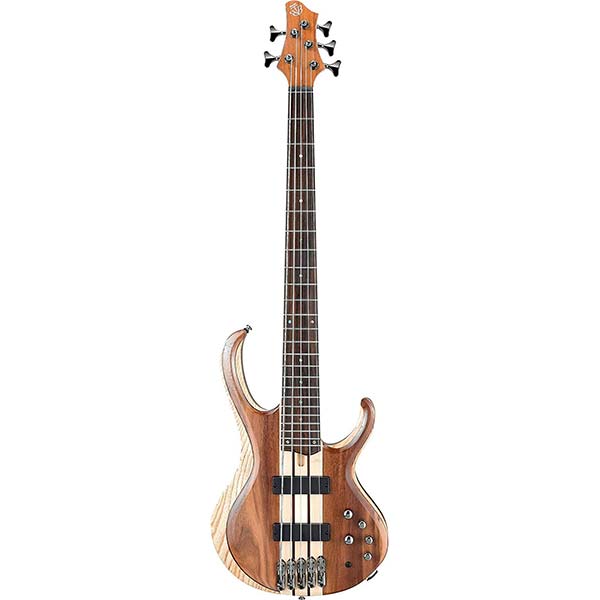
| Estimated Price | $900 |
| Strings | 5 |
| Body Wood | Okoume with ash wings, maple top |
| Finish | Satin |
| Neck | 5-piece maple/walnut, satin finish |
| Neck Joint | Set, neck-thru |
| Fingerboard | Jatoba |
| Fret Count | 24 |
My Review: Now we’re straying into modern territory once again with this next selection. The Ibanez BTB745 is a gorgeous instrument that defies the classic standard in exchange for something much more sleek and eye-catching. With five strings, a double humbucker configuration, and an active EQ, the tonal capability of this bass easily matches, if not surpasses its looks.
Build Materials: Like the Schecter Stiletto, the neck on the BTB745 continues straight through the body and is made of laminated maple and walnut. The wings of the body are ash topped with beautiful Okoume.
Hardware, Electronics, and Controls: The bridge is a top-loaded Mono-rail V, which is basically five separately mounted saddles. The tuners are die-cast machines with triangle keys. The BTB745 has two Bartolini BH2 Humbuckers that can be panned by a balancer knob. The active EQ has 3-bands as well as a 3-way frequency selector for the midrange control.
Finish: The neck finish is satin and the body is a natural low gloss finish. Of course with a wood selection this beautiful, natural finish is the only way to go.
Bottom Line: Though it’s similar to the Schecter Stiletto V, this bass has a bit more tonal capabilities with a mid-range selector switch and a different wood selection. It was a close call, but the Stiletto was a bit more attractive in my opinion, so I gave it a higher place. Both basses are top-notch, however, and beauty is in the eye of the beholder, so the choice is yours.
Popular Related Article: The 14 Best Acoustic Bass Guitars
10. Fender Player Jazz Bass V
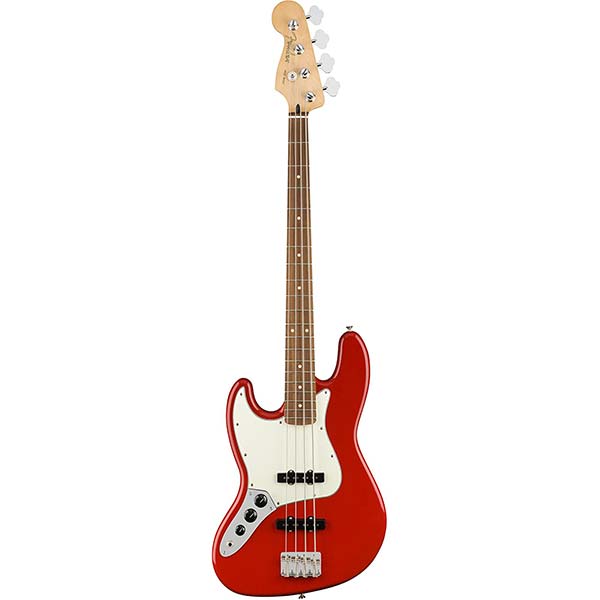
| Estimated Price | $800 |
| Strings | 5 |
| Body Wood | Alder |
| Finish | Gloss |
| Neck | Maple, satin finish, Modern C profile |
| Neck Joint | Bolt-on |
| Fingerboard | Pau Ferro |
| Fret Count | 20 |
My Review: As I mentioned earlier, the Fender Player Series is going to make a few appearances on this list. There are a ton of options available in this line, and every one of them is an excellent value. The Player Jazz Bass V is for the Fender fanatic who wants a low B string. It’s as simple as that. The quality and craftsmanship are on par with the Player P-bass from earlier in the list, and it’s well above many other basses in this price range.
Build Materials: There are no surprises here. The Player Jazz Bass V has a solid alder body and a maple neck with a walnut skunk-stripe. Though it may seem obvious, it’s worth mentioning that the neck is significantly wider than a standard Jazz Bass to accommodate the extra string. I only bring it up because one of the draws of a Jazz Bass is a slim neck, but that isn’t the case if you go with a five-string. There is no maple option for the fingerboard, but the Pau Ferro looks great nonetheless.
Hardware, Electronics, and Controls: Just like a standard Jazz, this bass has two single-coil Player Series Alnico pickups with their own volume controls and a master tone. The bridge is a standard top-loaded bridge plate, and the tuners are standard open-gear machines with clover keys.
Finish: Just like most of the Fenders we’ve looked at so far, the neck finish is satin and the body finish is gloss. It comes in a 3-tone Sunburst or Polar White.
Bottom Line: There’s not much to this one, folks. It’s a classic style with an extended range. The Player Jazz Bass V has the same great quality as other Mexican Fenders but suits the needs of a bassist in the market for a five-string bass.
11. Ibanez SR506E
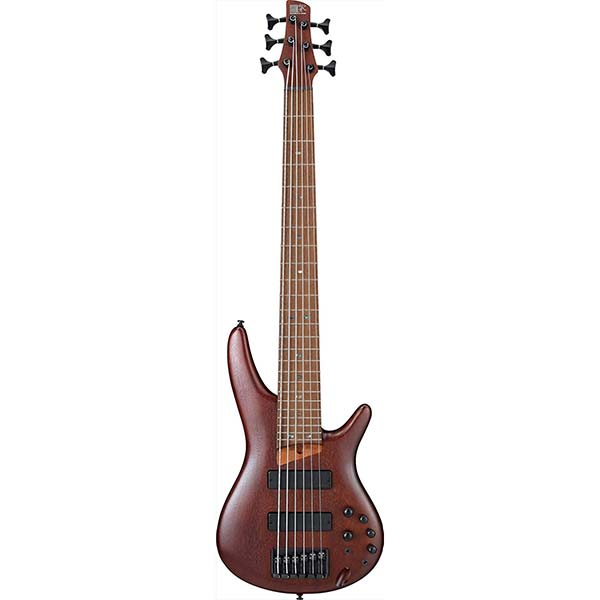
| Estimated Price | $750 |
| Strings | 6 |
| Body Wood | Okoume |
| Finish | Satin |
| Neck | 5-piece jatoba/walnut, satin finish |
| Neck Joint | Bolt-on |
| Fingerboard | Jatoba |
| Fret Count | 24 |
My Review: The Ibanez SR506E is the first six-string bass on the list. When it comes to modern interpretations of the bass guitar as an instrument, Ibanez is a true pioneer. The SRC body style is simple and elegant, and the overall style of this bass is clean-cut and modern. With two Bartolini BH2 pickups and an active EQ, the tonal options are abundant, and the extended range is for the bassist who wants to dabble in harmony (or double the guitarist).
Build Materials: The neck is a bolt-on five-piece laminated jatoba and Walnut, which gives it a very subtle striping on the back, and the fingerboard is jatoba. The body is solid Okoume. This may make it heavier than other basses, but it greatly increases the sustain.
Hardware, Electronics, and Controls: The bridge is top-loaded and the tuners are standard SR machines with triangle keys. It has two Bartolini BH2 Humbucker pickups that can both be adjusted with a master volume and blended with a balance knob. There is an active 3-band EQ that includes a mid range selector switch and a bypass switch.
Finish: The SR506E comes in a flat natural finish that looks great over the Okoume body. The neck also has a natural satin finish.
Bottom Line: The design of the SC506E is simple, which is perfectly deceiving for a bass with such a wide range and tonal capacity. As I mentioned earlier, Ibanez is ahead of the game when it comes to modern bass guitars, so it only makes sense that they would have some of the best six-string basses on the market.
12. Fender Mustang PJ Bass
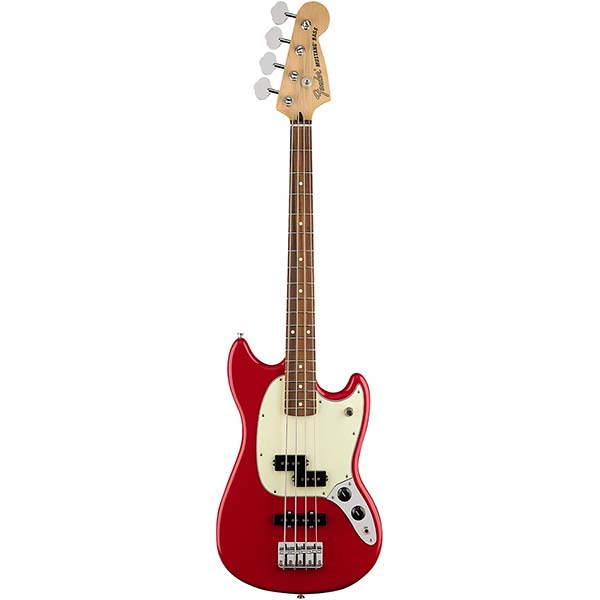
| Estimated Price | $550 |
| Strings | 4 |
| Body Wood | Alder |
| Finish | Gloss |
| Neck | Maple, satin finish, C profile |
| Neck Joint | Bolt-on |
| Fingerboard | Pau Ferro |
| Fret Count | 19 |
My Review: Another Fender? Yes, yes, another Fender, but don’t worry, this company puts out tons of options with enough variation to keep it interesting. Also, as I said before, Fender has some of the best quality instruments in the market and at decent prices, too. Though the pickup configuration is the same as many basses on the list sofar (both from Fender and other manufacturers alike) the Mustang PJ has a short 30” scale length and a tiny body, which makes it perfect for smaller players or anyone who just like the feel of a slimmer instrument. The price is also great for an instrument from Fender’s Mexican factories.
Build Materials: Though it’s much smaller, the Mustang sticks to Fender’s typical tonewoods. It has an alder body and a maple neck with a walnut skunk stripe. There are no body contours, but it hardly needs them with its reduced size.
Hardware, Electronics, and Controls: The Mustang has a standard top-loaded bridge plate and open-gear tuners. The PJ pickups are Vintage-Style and they can be switched by a 3-way pickup selector, rather than having their own volume. The remaining controls are the master volume and master tone.
Finish: The neck finish is satin and the body is gloss. Though the color options differ depending on the retail site, you can find the Mustang in Buttercream, Seafoam Green, Tidepool, Sienna Sunburst, Torino Red, or an Aged Natural finish.
Bottom Line: It’s the same classic Fender sound in a tiny package. There’s not much more to say. The value is great, and you can expect the quality to be well beyond its price point. If you’re in the market for a traditional-sounding short-scale bass, you won’t go wrong with the Fender Mustang PJ. This is easily one of best bass guitars out there considering its performance and overall value.
13. Guild Jumbo Junior Acoustic-Electric Bass
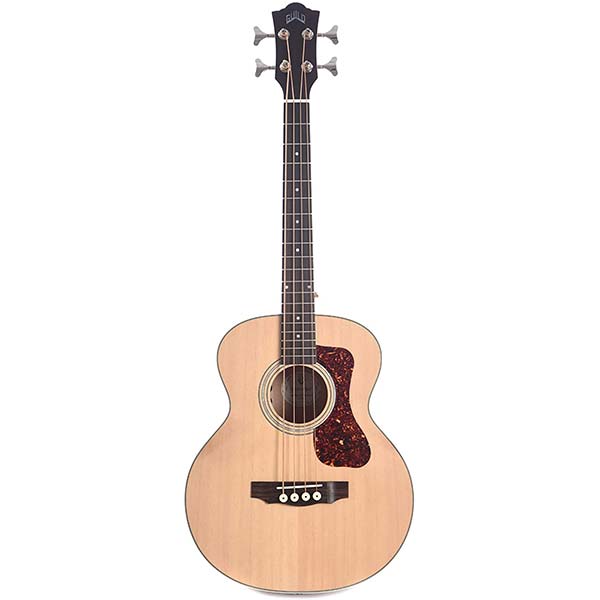
| Estimated Price | $500 |
| Strings | 4 |
| Body Wood | Stika spruce top, maple back, and sides |
| Finish | Satin natural finish |
| Neck | Maple, satin finish |
| Neck Joint | Set |
| Fingerboard | Ebony |
| Fret Count | 19 |
My Review: Though it’s a very niche instrument, the acoustic bass guitar has been growing in popularity. The increase of interest in the instrument has led some manufacturers to make some great products, even if they aren’t your typical bass guitar. Guild, a company most popular for its acoustic and hollow-body guitars has done exactly this with the Jumbo Junior. It’s small (closer to the scale of a guitar than a bass), but it has an acoustic sound that is one step closer to upright bass, but still incredibly unique.
Build Materials: The Jumbo Junior has a maple neck, back, and sides, and the top is Stika spruce, which is a very popular tonewood for acoustic tops. This is because spruce is incredibly resonant and allows the instrument to project easily, which is perfect for bassists that want a solely acoustic instrument. The bridge and fingerboard are both made of ebony, which is an incredibly durable hardwood.
Hardware, Electronics, and Controls: The tuners are die-cast machines with triangle keys. The Jumbo Junior can also be amplified through an onboard active preamp and piezo pickup. A master tone and volume control can be accessed discreetly through the soundhole.
Finish: A natural satin finish on both the neck and body allows for a beautiful blonde look the contrasts wonderfully with the ebony fingerboard and bridge.
Bottom Line: You have to know what you’re getting into if you get an acoustic bass. Electric bass guitars dominate most genres, so the niche for acoustic bass is pretty thin. That being said, there is a place for it, and it is growing in popularity. If you are looking for an acoustic bass sound akin to an upright, then the Guild Jumbo Junior may be the way to go.
14. Fender Player Fretless Jazz Bass
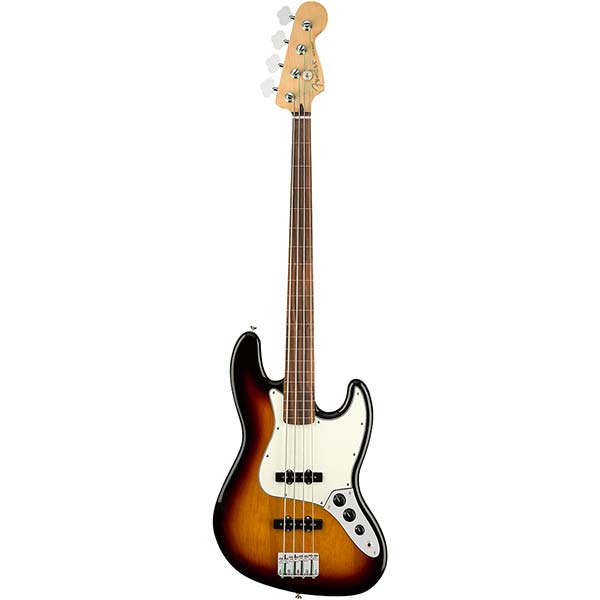
| Estimated Price | $700 |
| Strings | 4 |
| Body Wood | Alder |
| Finish | Gloss |
| Neck | Maple, Modern C profile, satin finish |
| Neck Joint | Bolt-on |
| Fingerboard | Pau Ferro |
| Fret Count | Fretless |
My Review: I know, I know, there are a lot of Fenders but don’t worry, this is the last on the list. I tried to keep them broken up a bit, but it’s hard not to place them at least somewhere in the first half; they’re just that good! This fretless Jazz Bass is another offering from the Player series, and it is no exception to the rule of quality. Fretless basses have a very special sound that has popped up on popular albums all throughout the ‘70s and ‘80s. Jaco Pastorious, who is often cited as one of the best bassists in history, is known for exclusively using a fretless Jazz Bass. Paul Simon’s 1986 album, “Graceland” always comes to mind because Baktithi Kumalo, a phenomenal South African studio bassist, used a fretless bass in a majority of the tracks and it gives the whole album a spectacular vibe.
Build Materials: As you should expect from Fender, this bass has an alder body and a maple neck with a walnut skunk stripe. The fingerboard comes in Pau Ferro and has markers for the frets to help you keep your place while playing.
Hardware, Electronics, and Controls: Just like the other Player series basses on the list, the Fretless Jazz Bass has a standard top-loaded bridge plate and open-gear tuners with clover keys. The two Player Series Alnico V Jazz Single-coils each have volume control and are tied to a master tone.
Finish: The gloss body finish comes in a 3-tone Sunburst or Polar white, and the finish is satin.
Bottom Line: If you’re getting sick of seeing Fenders on the list, I have two things to tell you. First, this is the last one. Second, the amount of Fenders I’ve reviewed is a testament to their versatility and quality. Are they for everyone and every situation? Absolutely not. But, there is a really good chance that they have a bass somewhere in their catalog that can fill most of your needs. I can’t say that about any other brands. The Player Fretless Jazz Bass is an excellent fretless option, but that doesn’t mean there are others. We’ll take a look at some later on in the list.
15. Yamaha TRBX605FM
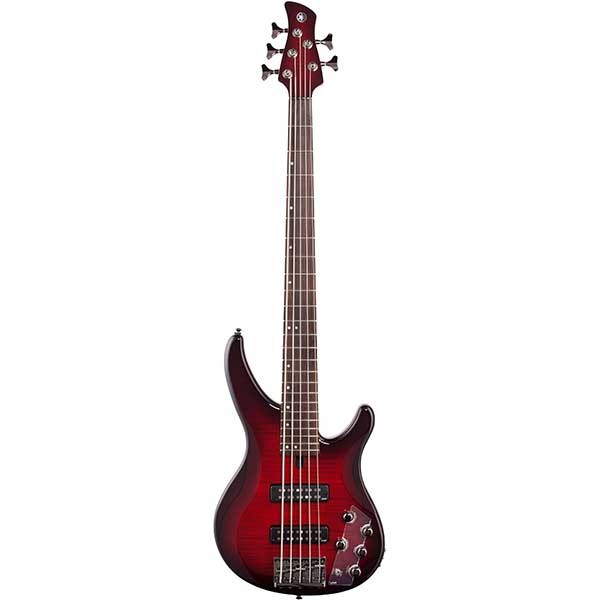
| Estimated Price | $650 |
| Strings | 5 |
| Body Wood | Alder |
| Finish | Gloss |
| Neck | Maple and mahogany |
| Neck Joint | Bolt-on |
| Fingerboard | Rosewood |
| Fret Count | 24 |
My Review: My second offering from Ibanez is quite different from the Broad Bass I put in fifth place. The TRBX605FM is an excellent active (or passive) five-string bass for the $600-$700 range. Double humbuckers and an active preamp really make this bass growl, but the preamp can also be switched off if you want a more mellow sound (or you’re short a 9v battery). The EQ gives you a lot of options in terms of tone, and this bass is easy on the eyes as well.
Build Materials: The body is alder, which increases low-end and low-mid sustain. The neck is bolt-on five-piece laminate maple and mahogany.
Hardware, Electronics, and Controls: The bridge plate is top loaded and the tuners are die-cast machines with triangle keys. The TRBX605FM has two YGD H5 humbuckers that can be blended with a balance knob. The active preamp has a 3-band EQ and it’s switchable to a passive mode.
Finish: The neck consistently has a natural satin finish, but you can choose between a Natural Satin, Matte Amber, or gloss finish. The gloss finishes come in Dark Red Burst and Translucent Black.
Bottom Line: With a more moderate price range than some of the earlier active five-strings, the TRBX605FM is an excellent value. It includes many features found in more expensive five-strings, while also including a passive/active switch, which isn’t common on many instruments. If your wallet can’t handle the $800+ price tags on basses like the Schecter Stiletto, this is an excellent option that will save you some cash.
16. Epiphone EB-3
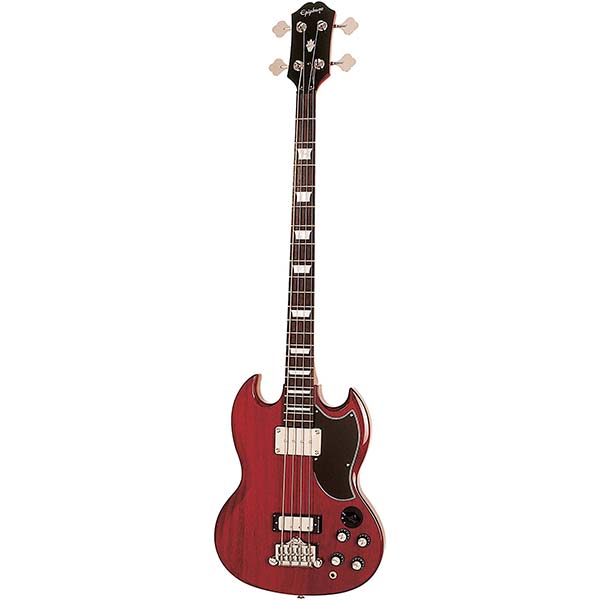
| Estimated Price | $400 |
| Strings | 4 |
| Body Wood | Mahogany |
| Finish | Gloss |
| Neck | Mahogany, SlimTaper “D” profile, gloss finish |
| Neck Joint | Set |
| Fingerboard | Rosewood |
| Fret Count | 22 |
My Review: Fender may be the top dog when it comes to classic basses, but Gibson has a few instruments that easily compete. Gibson’s daughter company, Epiphone, has remade some of these instruments at a very affordable price and great quality. The EB-3 is a remake of Gibson’s SG Bass, and it lives up to its predecessor. It is certainly a classic look, but since it’s swimming in a sea of Fenders, it still stands out with a unique look and sound.
Build Materials: Like all Gibson guitars, both the body and the neck are made of mahogany, and the fingerboard is rosewood. The wood selection combined with a set neck allows this bass some serious sustain.
Hardware, Electronics, and Controls: The neck pickup is a Sidewinder humbucker and it has an NYT Bass mini-humbucker at the bridge. These pickups can be singled out or combined by a 3-way rotary switch. Each humbucker has its volume and tone control, which gives it a little more tonal control than basses with a single master tone. The bridge has an interesting stop-tail design and four adjustable saddles. The tuners are open-gear machines with clover keys.
Finish: Both the neck and body are finished in gloss. The EB-3 is available in Cherry and Ebony.
Bottom Line: Epiphone may get a bad rap sometimes, but they hit the nail on the head with this one. It looks and sounds great, and it offers a lot of tonal variation through its controls. The EB-3 is perfect for those who love the Gibson SG style but don’t have the budget for a $1,500 instrument.
17. Squier Classic Vibe Bass VI
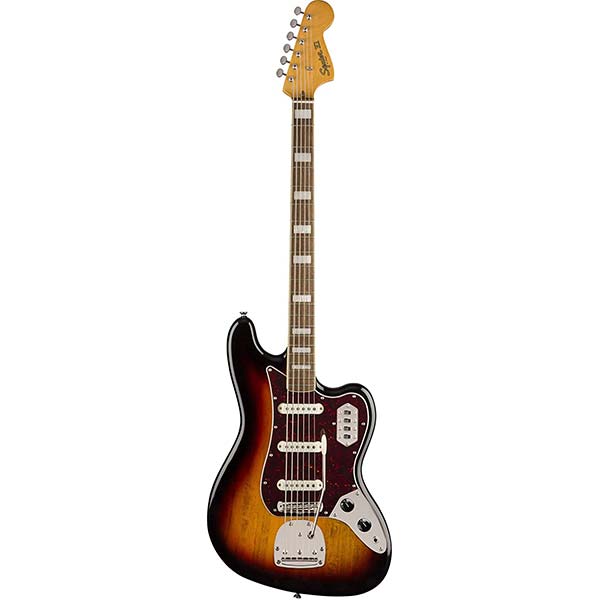
| Estimated Price | $500 |
| Strings | 6 |
| Body Wood | Poplar |
| Finish | Gloss |
| Neck | Maple, gloss finish, C profile |
| Neck Joint | Bolt-on |
| Fingerboard | Indian laurel |
| Fret Count | 21 |
My Review: The Squier Classic Vibe Bass VI is a truly unique instrument despite having a very traditional look (similar to a Fender Jaguar). At first glance, you may think this is a regular guitar, or maybe a baritone if you notice the scale is a bit larger, but it’s actually tuned a whole octave down from a standard guitar to put it in a bass range. It’s quite different from other six-string basses since it has no low B string, and the two upper strings are tuned to B and E like a guitar. The neck is incredibly slim and it plays more easily with a pick rather than fingers. If you want to transfer your guitar vocabulary onto bass, or you’re a bassist who wants an extended upper range, the Bass VI is an interesting hybrid instrument that can definitely help you out.
Build Materials: Like the other Squires on this list, the Bass VI has a solid poplar body, a maple neck with a walnut skunk stripe, and an Indian laurel fingerboard
Hardware, Electronics, and Controls: Like the original Fender Bass VI, there are three single-coil pickups that can all be switched on and off. The fourth switch is a bass roll-off switch which adds a little extra tonal control when combined with the tone knob. The bridge is a Jazzmaster style tremolo (yes that’s right, a tremolo on a bass), and the tuners are Vintage Style, closed-back tuning machines with button keys that are closer to guitar tuners than bass.
Finish: Unlike the other Squires (and Fenders) on the list, the Bass VI neck is finished with a Vintage Gloss, just like Fender’s original Bass VI. The body is also gloss, and it comes in a 3-Tone Sunburst and Black.
Bottom Line: I mentioned earlier that the Yamaha Broad Bass was my favorite on the list, but the Squire Bass VI takes second place, easily. Though typical six-string basses are unique in their own right, a six-string that forgoes the low B in exchange for an extended upper register is a rare sight, and definitely walks the line between bass and guitar. It’s certainly an oddity (though still a classic, somehow), but the Bass VI is a beast of an instrument that will reward anyone who decides to step out of the norm and give it a chance.
18. Ibanez AGB200
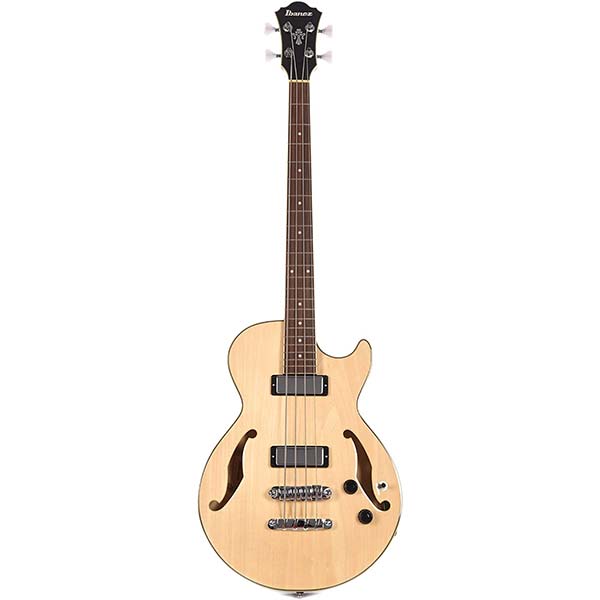
| Estimated Price | $550 |
| Strings | 4 |
| Body Wood | Maple |
| Finish | Gloss |
| Neck | Maple, gloss finish |
| Neck Joint | Set |
| Fingerboard | Laurel |
| Fret Count | 22 |
My Review: If the Gretsch 5440LS Electromatic was a bit above your budget (like it would be for me), the Ibanez AGB200 might be the perfect compromise. Though it’s not a true hollow body, the chambered semi-hollow body still offers up that woody tone that you may be looking for. Like the Electromatic, the AGB200 is all maple and has a double humbucker pickup configuration. This also might be a good option for someone who wants a short-scale semi-hollow that isn’t as bulky as the Electromatic.
Build Materials: As I mentioned before, the body is laminated maple, and the neck is maple as well. The fingerboard is laurel with a gorgeous cream binding.
Hardware, Electronics, and Controls: The AGB200 has a top-loaded Gibraltar III Bridge and die-cast tuning machines with triangle keys. It has two Ibanez Classic Elite Bass Humbuckers that can be switched by a 3-way pickup selector, and they’re both controlled by a master volume and tone.
Finish: The top is finished in a beautiful Blonde gloss, and the back, sides, and neck are finished in glossy natural walnut.
Bottom Line: With a slimmer profile and a lower price, the AGB200 is perfect for anyone who wants the woody tone of a hollow body in an instrument that isn’t as bulky or pricey as the Electromatic Bass.
19. Squire Classic Vibe 70s Jazz Bass V
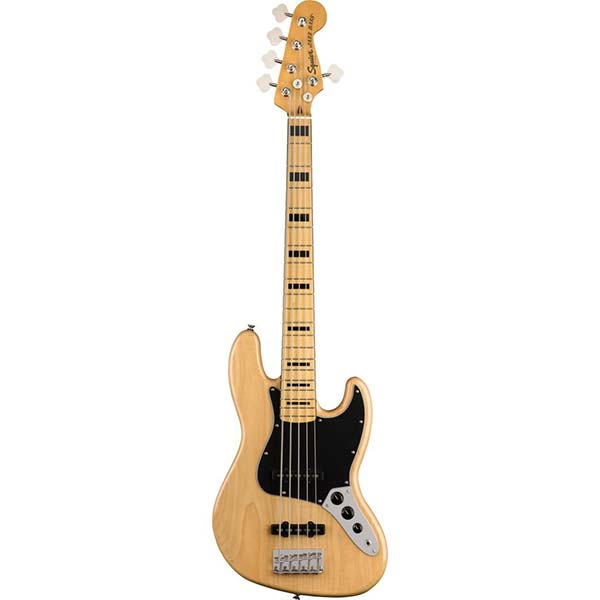
| Estimated Price | $450 |
| Strings | 5 |
| Body Wood | Poplar |
| Finish | Gloss |
| Neck | Maple, vintage gloss, C profile |
| Neck Joint | Bolt-on |
| Fingerboard | Maple |
| Fret Count | 20 |
My Review: Though it’s from the same line as the Squire Bass VI, the ‘70s Jazz Bass V is a much more traditional instrument. A typical five-string set-up and a vintage Jazz Bass style make this bass the perfect alternative to pricier Fender models.
Build Materials: Like most squire models, the body is poplar and the neck is maple with a walnut skunk stripe. The fingerboard is also maple and has a vintage-style black binding.
Hardware, Electronics, and Controls: The ‘70s Jazz Bass V has standard open-gear tuners with clover keys and a standard top-loaded bridge plate. The pickups are Alnico single-coils, with their own volume and a master tone.
Finish: The body is finished in gloss and available in Black or Natural. The neck and fingerboard are also glossy and are finished with a vintage tint.
Bottom Line: If you’re looking for the best bass guitar under $500, this is an excellent option. Though it’s not quite a Fender Jazz Bass V, the quality of the Squire ‘70s Jazz Bass V is great for its price point. It also offers up a bit of stylistic variation with the vintage glossed neck and a bound fingerboard. If the Fender models are above your budget, this is an excellent compromise.
20. Gretsch G2220 Junior Jet Bass
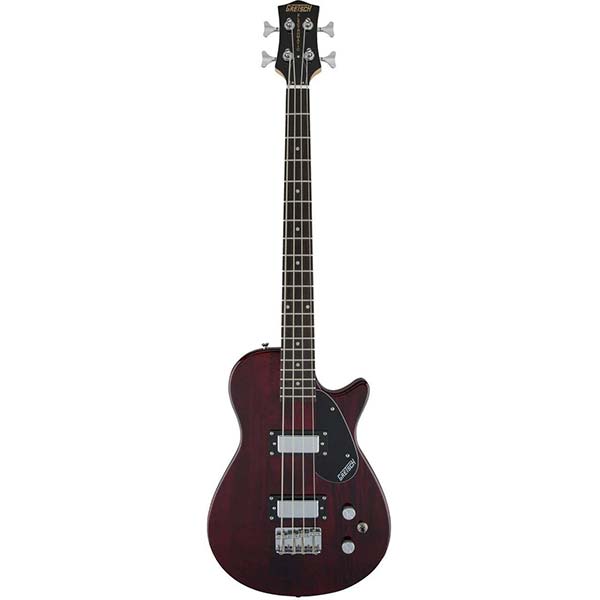
| Estimated Price | $300 |
| Strings | 4 |
| Body Wood | Basswood |
| Finish | Gloss |
| Neck | Maple, gloss finish |
| Neck Joint | Bolt-on |
| Fingerboard | Black walnut |
| Fret Count | 20 |
My Review: Now we are getting into some true budget instruments. Luckily Gretsch still knows how to keep it interesting, even at the $300 price point. The G2220 Junior Jet Bass II has a unique style and some serious sound for such a low price. It’s a short-scale bass with a tiny body, but the tone is still there.
Build Materials: The body is basswood, which has a very warm sound and provides a strong midrange. Basswood is also incredibly light, so (along with the short scale) it makes this bass perfect for smaller players. The bolt-on neck is maple and it has a black walnut fingerboard.
Hardware, Electronics, and Controls: The hardware is pretty typical here. It has a top-loaded bridge plate and die-cast tuners with triangle keys. The two Mini Bass Humbuckers pack a lot a punch and they can be switched with a 3-way selector.
Finish: The neck has a simple satin finish, and the body is glossed and available in Torino Green or Walnut.
Bottom Line: This is the perfect budget bass for small players or anyone who wants big tone in a tiny package. The G2220 Junior Jet Bass II brings a great sound and a unique look at an excellent price.
21. Ibanez Talman TMB-100
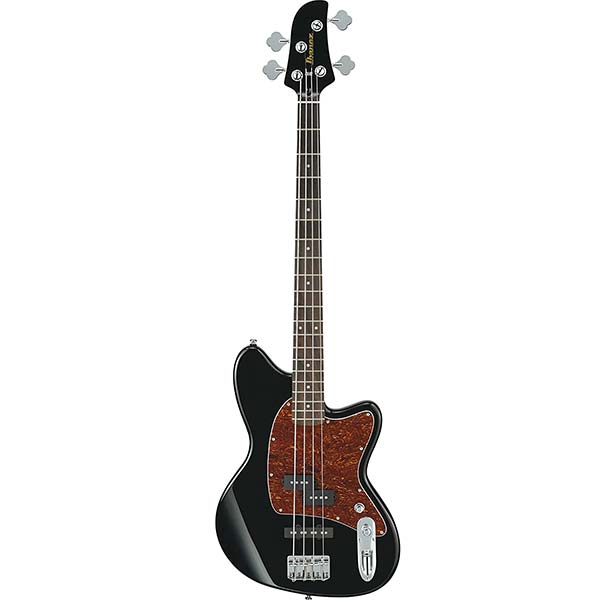
| Estimated Price | $200 |
| Strings | 4 |
| Body Wood | Poplar |
| Finish | Gloss |
| Neck | Maple, satin finish |
| Neck Joint | Bolt-on |
| Fingerboard | Jatoba or maple |
| Fret Count | 20 |
My Review: Don’t be fooled by the low price! Though this is the cheapest bass on our list, the Ibanez Talman series is well known for bringing great quality at extremely low prices. Like Gretsch, Ibanez isn’t satisfied with just making Fender copies for their low-end models. The TMB100 has a unique look and a wide variety of finishes. Also, this is probably the cheapest bass you’ll see with an active pre-amp and EQ.
Build Materials: Like most Squire basses, the Talman has a polar body and a bolt-on maple neck.
Hardware, Electronics, and Controls: A standard top-loaded bridge-plate is expected at this price point, but the tuners are nice open-gear machines with clover keys. The Dynamix pickups are in a PJ configuration and can be blended with a balance knob. The volume is a master control, and the active EQ has two bands.
Finish: The neck has a satin finish and the body is glossed. The finish is available in Black, Ivory, Mint, or Tri-Fade Burst.
Bottom Line:A unique style and an active preamp are truly above and beyond for bass at this price point, which is what puts the TMB100 on the list instead of some P-Bass knockoff. If your budget is this tight, the Talman is one of the best options available.
Choosing the Right Bass Guitar (Buying Guide)
There are a lot of things to consider when buying an instrument, especially if you don’t have a solid idea of what you’re looking for. The market has a multitude of instruments to suit every style and every budget, which can be quite overwhelming when you first dig into it. In this buyer’s guide, we’re going to first look over the anatomy of a bass guitar and get familiar with the vocabulary we’ll be using. This way you’ll know exactly I’m talking about when you read over the specs of different instruments. After that, there will be three sections diving into body style, string count, and passive vs. active. Deciding on these three factors will narrow down your search and help you find the bass that best fits your needs.
Bass Guitar Anatomy
Body: The most distinctive part of a bass guitar is the body. This is the part of the bass that houses the pickups, wiring, and controls, and it is what the bridge and neck are mounted to. Bodies are almost always made of wood, but the type of wood can affect the tone, weight, and price range of the instrument. Popular woods for bass bodies include maple, alder, ash, and mahogany. I’ll get into the specific qualities of these different woods on a case by case basis in the review section. Bodies also vary greatly in style, but we will discuss this in a separate section.
Neck: The neck is the length of wood mounted to the body that holds the string tension and the fretboard. Usually, necks are made of maple though other woods can be used. Necks can have different thicknesses and shapes to cater to different players. This is known as the neck’s profile. Necks naturally bow under string tension, so they have a metal rod that runs through the center to stiffen them. This is called the truss rod and it can be adjusted to control the bow, or relief, in the neck.
Fretboard: The fretboard or fingerboard is a piece of wood on the face of the neck underneath the strings. They can be made of maple, but they are commonly made with a hardwood such as rosewood or ebony. The nut sits at the top of the fretboard and starts the speaking length of the strings while also holding them in place. Nuts are usually made out of bone or plastic synthetic bone. Fretboards are lined with metal strips called frets. They allow you to raise the pitch of the string by pinching it against the fret. The amount of frets on a bass determines how high you can play, but usually, there is only a fret or two difference between different basses.
Headstock: The headstock, like the body, is another distinctive part of the bass. It is located at the top of the neck and is made from the same wood. The headstock holds the tuning machines (also called machine heads or tuners) which anchor the strings above the nut and also allow you to tune them. The shape of the headstock has little bearing on the sound, so this is up to aesthetic preference.
Bridge: The bridge is the piece of hardware that anchors the end of the strings to the front of the body. The two main types of bridges are thru-body and stop tail (or top-loaded). Thru-body bridges align with holes in the body with grommets on the other side and, just as the name suggests, the strings anchor in these grommets and go through the body. A stop tail bridge allows the strings to anchor to the bridge itself or a separate tailpiece. Thru-body bridges tend to provide more tuning stability and sustain, but they also produce more tension in the string which may feel undesirable to play. Some bridges have both options and allow you to choose. The strings sit on parts called saddles which are typically adjustable. This allows you to make minor changes in the string length and height to set the intonation and action respectively.
Pickups: The pickups are magnets wrapped in wire that capture the string’s vibration and convert it into an electrical signal. They are mounted to the front of the body, underneath the strings. There are several styles of pickup that produce different tones when amplified. The placement of the pickups under the strings also affects the tone the instrument produces.
Controls: The controls allow you to adjust the output volume and tone of the instrument. At the least, bass guitars usually have a master volume knob and a master tone knob. The volume knob does as the name suggests, and the tone knob removes high-end from your tone. Though some basses may have pickup selector switches that allow you to switch between pickups, this is more common on guitars. Basses more often have a separate volume knob for each pickup, as opposed to a selector switch.
Body Style
Bass bodies come in a variety of styles. While this may seem like an aesthetic aspect, different body styles can greatly affect tone and playability. Most bass guitar bodies are solid wood, but there are also hollow-body basses. Hollow bodies or semi-hollow bodies (sometimes called chambered bodies) will have a woodier sound when they are amplified. Solid wood bodies suit most (if not all) genres, but you may want to consider a hollow-body if you are looking to emulate some sounds from the ’60s to early ‘70s pop-rock (most notably the Beatles) or if you play jazz or bluegrass and you want to relate to the sound of an upright bass. However, this isn’t a rule! Hollow-body basses can also be used in many different styles as well (though you may feel a little awkward with one in a heavy metal band). It’s all up to your taste in aesthetics and tone.
Cutaways are sections that are removed from the top of the body to allow easier access to high frets. Solid-body basses often have two cutaways, but the one below the neck is the only one that helps you play in the top octave. The top cutaway may aid in weight reduction, and it certainly changes the appearance of the instrument. Hollow and semi-hollow bodies can also have cutaways. Bodies can also be contoured which can make them sit more comfortably against you while you play and also help reduce weight.
String Count
While traditionally, basses have only four strings, (E, A, D, and G in standard tuning), basses with added strings are becoming more and more popular. Five-string basses include a lower B string. This greatly extends your low-end range, making your bass more versatile. It’s somewhat of a point of contention between bassists, whether a four-string is better than a five-string. Some claim that it’s easier to start with a four-string, and in the long run, tradition wins out over some newfangled low B string. Others say that the extended range is almost necessary with the musical repertoire that’s popular today, and five-string basses should be the new standard. Though I play a four-string bass, I am of the mind neither is truly better and it solely depends on the player. Five-strings are a bit difficult for me to play, but that is most likely because I learned on a four-string (and anyone who says four-strings are easier probably did, too). If you are just learning to play the bass, one more string won’t make much of a difference since everything is new to you anyway. If the extra range is appealing to you, you should start with a five-string. It will only help you in the long run since you will become comfortable with it right off the bat. However, I don’t think that four-string basses are obsolete by any means. Besides being cheaper than five-string basses of the same caliber (which is something everyone can get behind), the legacy of four-string basses cannot be overlooked. Many wildly famous bassists made a name for themselves on only four strings. I think this could be due to the way creativity thrives under limits and restrictions. The simplicity and narrower range of a four-string can make it a little easier to think outside of the box in attempt to distinguish yourself.
Of course, there is one more option you may have heard about. Though they aren’t nearly as common as four or five-string basses, six-string basses have found a place among some musicians. Like the five-string bass, the six-string has a low B string, but it also adds a high C string to extend its range upwards as well. Typical bassists tend to stick to basslines and maybe midrange melodies if they have the chance to solo. The six-string bass is for the bassist who is unsatisfied with only playing bass lines. If you have an interest in delving into more melodic playing or even trying harmony on your new bass (i.e. chords), a six-string might be up your alley. Just like with the five-string, if you intend on playing a six-string bass at some point, you might as well start with it. Six-strings require slightly different and more precise techniques when compared to a four or five-string, so it is best to develop this while you are learning. I should include a warning though. Six-string bass necks are incredibly wide, so bassists with small hands should take this into consideration.
At the end of the day, you can play any type of music on any number of strings. However, I suggest you research what instruments your favorite bassists play. If a few of them use a five or six-string, getting a similar bass might be something to consider. If all of them use four-strings, you’d do best to get a four-string as well if you are trying to emulate their sound. You may be tempted to just get a six-string in the spirit of “better safe than sorry.” To this I say: paying for an extra string that never gets used can be just as disappointing as not getting enough strings.
Active or Passive
The final major decision you need to make before you start shopping for your new bass is whether you want it to be active or passive. Passive basses are more common and more simplistic in terms of their controls. They directly translate the vibration of the string to an electrical signal. Usually, the only controls available on a passive bass are for volume and tone. Volume is rather self-explanatory. The tone is a control that rolls off high-end frequencies. Sometimes the pickups have a switch to change the selection of them, and other times they are blended by a balance knob or separate volume controls. With an active bass, you usually have more controls at your disposal when it comes to shaping tone. Most masses with an active preamp will include a 3-band EQ, though some only have 2-bands. These will allow you to cut or boost bass, treble, and midrange frequencies, whereas a passive tone knob will only allow you to cut the treble. Active basses also have a higher output gain which makes them sound much more present. Active basses have a solid use in louder and heavier genres of music such as metal and hard rock, but there is no set rule as to which type of bass is suitable for your preferred style of music. Also, keep in mind that everything a passive bass lacks in comparison to an active bass can be made up through effects and the controls on your amplifier. Having an active preamp and EQ in the bass itself just gives you more control of your tone without the need for more gear.
Wrap Up:
That does it for this review. Let us know what bass guitar you’re going with or if you think there are any guitars that we should add to this list.


Why are the Fender Ultra bass models not included? They are patently better than the older ones you list. Particulary the Ultra Precision which covers both Jazz and Precision sounds and is active/passive.
I need to see all the Ibanez bass guitar & their prices below, it’s really urgent